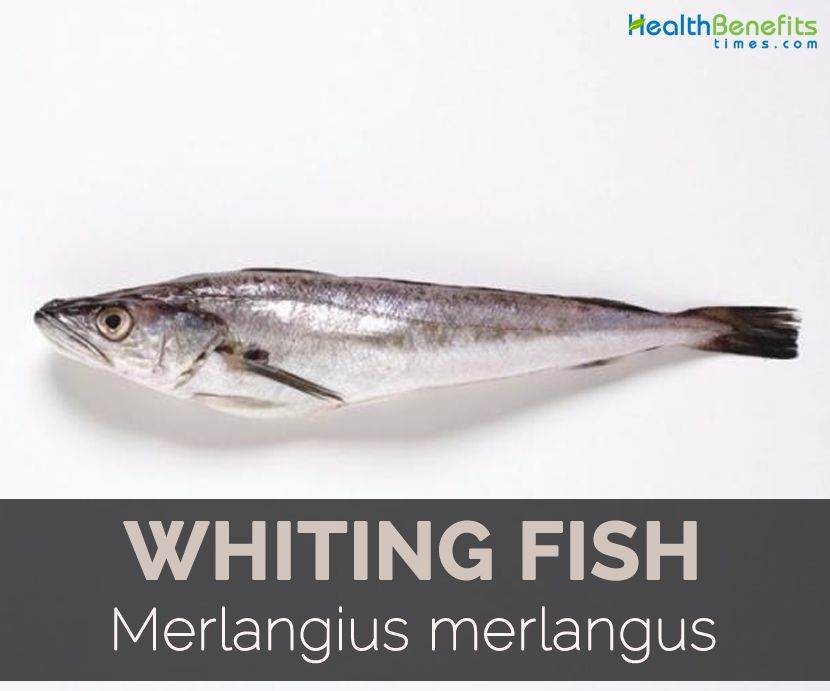Nutritional value
In 85 grams of cooked whiting fish, it offers 63.5 g of water, 99 calories, 19.96 g of protein, 1.44 g of total lipid fat and 1.24 g of ash. The same serving size offers 92.08% of Vitamin B12, 63.45% of Selenium, 55.02% of Isoleucine, 54.81% of lysine, 50.91% of tryptophan, 49.72% of threonine, 48.67% of valine, 47.65% of histidine, 43.89% of leucine, 39.92% of protein, 34.57% of phosphorus, 12.87% of choline and 11.77% of Vitamin B6.
Health Benefits of Whiting fish
Whiting fish is packed with various amounts of nutrients, minerals, vitamins, lipids and amino acids. Due to the presence of these nutrients, it provides ample amount of health benefits. Some are discussed below:
- Forms DNA
It helps to form DNA in the body. Vitamin B12 is essential for the division of cells. The deficiency of Vitamin B12 results in the abnormal cell formations called magaloblasts. It could also lead to anemia.
- Lowers fatigue
It provides relief from the weakness and fatigue. Vitamin B12 has the ability to improve stamina of body to combat heavy work pressure.
- Bone health
Phosphorus is essential for the growth and maintains the teeth and bone health. It promotes the tooth enamel and gum health. It also provides relief from the conditions such as loss of minerals density and bone loss called osteoporosis. It also ensures the health of skeletal structure. Phosphorus is associated with heart health and prevents the chances of cardiovascular ailments. (1) (2)
- Supports digestion
Phosphorus is vital for supporting digestion. It stimulates niacin and riboflavin. Vitamin B is essential for the metabolism of energy. It clears constipation, indigestion, diarrhea and bowel movements. It helps to eliminate toxins from the body. (3)
- Lowers cholesterol
The high intake of niacin lowers the level of bad cholesterol and increase good cholesterol. It prevents the chances of atherosclerosis and thickening of artery walls.
- Mental problems
The supplements of niacin help to cure the mental derangement and other health conditions.
- Treat cramps
Magnesium helps to cure kidney stress, muscular tension and kidney stress. It assists calcium absorption that speeds up healing process. Its deficiency might show leg cramps and general fatigue. It treats the problems of chronic leg problems. (4)
- Prevent heart ailments
It prevents irregular heartbeats, damage and muscle stress. It soothe nerves and resolves digestive process. It also prevents indigestion, cramps, vomiting, constipation, flatulence and abdominal pain. The deficiency of magnesium could lead to heart diseases. (5)
Precautions
- The people who are allergic to fish should avoid it.
- The excessive intake might lead to side effects or worsen the health.
- People with health problems, breast feeding and pregnant women should consult the doctor before consumption.
How to Eat
- It is boiled, deep fried, grilled and poached.
- The fish is also added to stews, soups and various dishes.
Whiting fish facts
Whiting fish resembles the cod fish. It has small head, elongated body and pointed snout. It measures about 70 cm long with blue to green skin and silvery to white belly. It contains two anal fins and three dorsal fins. On the side, it has pectoral fins and pelvic fins are found near the gills. It thrives in gravel and mud beds or rocky bottoms. Female whiting fish lays up to one million of eggs that float in an open ocean. Its prey consists of shrimps, crabs, molluscs, squid, worms and cuttlefish.
| Whiting fish facts and nutritional information Quick Facts | |
|---|---|
| Name: | Whiting fish facts and nutritional information |
| Scientific Name: | Merlangius merlangus |
| Origin | Native to northeastern Atlantic Ocean |
| Colors | Yellowish, brown, greenish, dark blue |
| Shapes | Elongated body, small head, pointed snout, Length: 70 cm |
| Calories | 99 Kcal./cup |
| Major nutrients | Vitamin B-12 (92.08%) Selenium (63.45%) Isoleucine (55.02%) Lysine (54.81%) Tryptophan (50.91%) |
| Health benefits | Forms DNA, Lowers fatigue, Bone health, Supports digestion, Lowers cholesterol |
| Name | Whiting fish facts and nutritional information |
|---|---|
| Scientific Name | Merlangius merlangus |
| Native | Native to northeastern Atlantic Ocean |
| Common/English Name | English whiting, European whiting, Golden cutlet, North Sea whiting, Spelding, Whiting, Merling |
| Name in Other Languages | Arabic: Murluts, Nazalli, Peskadil’ia; Breton: morlouan; Bulgarian: Medjid, Medzhid; Catalan: Merlà; Corsican: Nasellu; Croatian: Pišmolj, Ugotica velika; Danish: Hvilling, Hvitting, Slinger; Dutch: Koudgerookte vlinders, Wijting; Faroese: Hvítingur; Finnish: Valkoturska; French: Lécaud, Merlan, Merlu, Nasellu, Varlet; German: Merlan, Witting, Wittling; Greek: Bacaliaros, Bakaliaros, Taouki, Ntaoúki (Νταούκι); Hebrew: Merlan; Icelandic: Làsa, Lýsa; Irish: An faoitín; Italian: Arface, Filetti affumicati, Merlano, Molo, Molo de parangal, Morgano, Nasello atlantico, Orfacio, Pisci fica; Mandarin Chinese: Yá xuě (牙鱈), Chǐ xuě de yìmíng (齒鱈的異名), Chǐ xuě de yì míng (齿鳕的异名); Manx: Finnag, Kelk; Norwegian: Hvitting, kviting; Polish: Witlinek, Witlinek czarnomorski; Portuguese: Badeho, Badejo, Badejo-do-Mar-Negro, Filete fumado; Romanian: Bacaliar; Russian: Merlang (Мерланг), Chernomorskaya, Chernomorskiy merlang, Merlang, Merlanka, Piksha; Serbian: Pismolj, Ugoti velika, Ugoti velika; Slovenian: Mol; Spanish: Liba, Merlan, Plegonero; Swedish: Vitling; Turkish: Bakalyaro, Bakalyaro baligi, Bakalyaro baligi |
| Tail | Truncate |
| Shape & size | Elongated body, small head, pointed snout, Length: 70 cm |
| Color | Yellowish, brown, greenish, dark blue |
| Belly | Silvery |
| Flavor/aroma | Mild |
| Diet | Eel-pout, lesser sandeel, sprat, herring, haddock, cod, crustaceans, squid, worms |
| Major Nutritions | Vitamin B-12 (Cobalamine) 2.21 µg (92.08%) Selenium, Se 34.9 µg (63.45%) Isoleucine 0.92 g (55.02%) Lysine 1.833 g (54.81%) Tryptophan 0.224 g (50.91%) Threonine 0.875 g (49.72%) Valine 1.028 g (48.67%) Histidine 0.587 g (47.65%) Leucine 1.622 g (43.89%) Protein 19.96 g (39.92%) |
| Health Benefits |
|
| Calories in 3 oz (85 gm) | 99 Kcal. |
| Precautions |
|
| How to Eat |
|
References:
https://www.organicfacts.net/health-benefits/vitamins/vitamin-b3-or-niacin.html
Comments
comments
